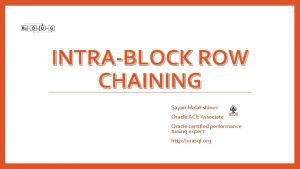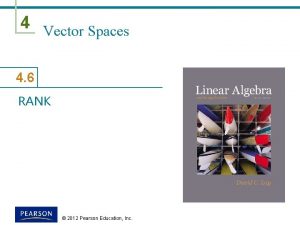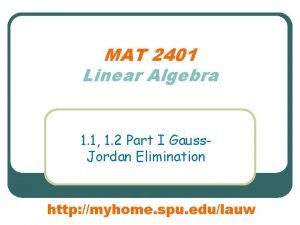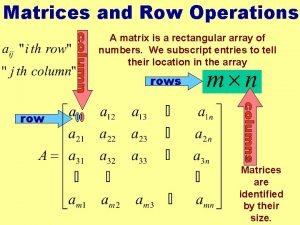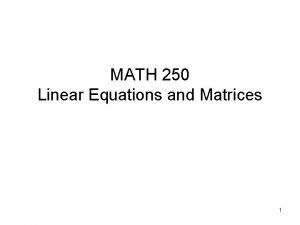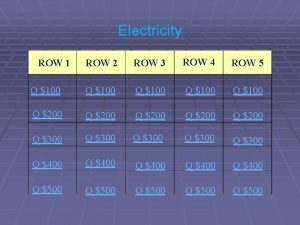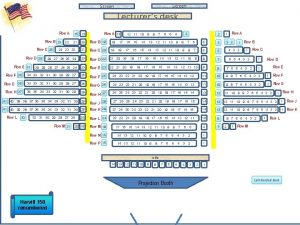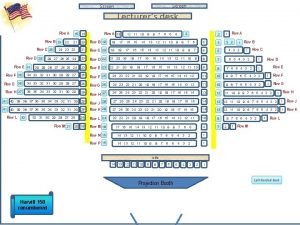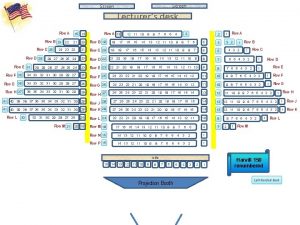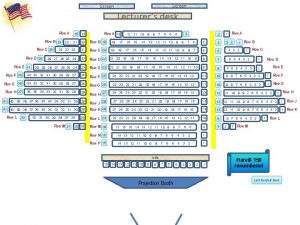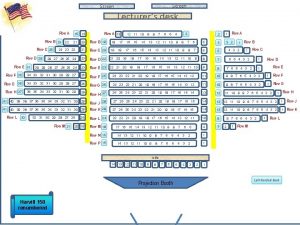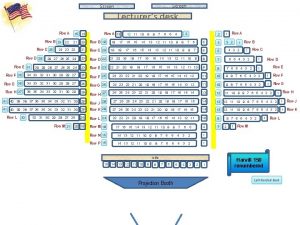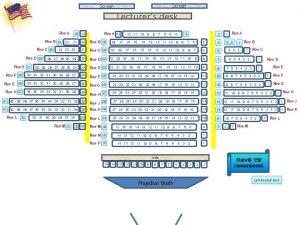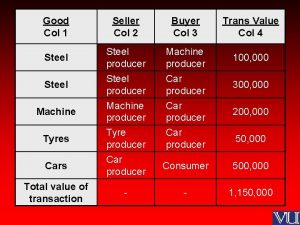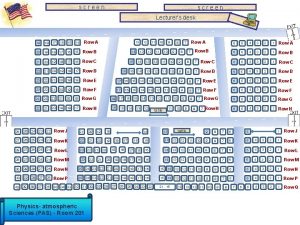Col 3 Col 2 Col 1 Row 1

![Col 3 Col 2 Col 1 Row 1 X[1][1] X[1][2] X[1][3] Row 2 X[2][1] Col 3 Col 2 Col 1 Row 1 X[1][1] X[1][2] X[1][3] Row 2 X[2][1]](https://slidetodoc.com/presentation_image/2b3e906ae2198c5714f8a563162fc5d9/image-2.jpg)
![Col 1 Col 2 Col 3 1 2 0 X[0][0] X[0][1] X[0][2] 1 X[1][0] Col 1 Col 2 Col 3 1 2 0 X[0][0] X[0][1] X[0][2] 1 X[1][0]](https://slidetodoc.com/presentation_image/2b3e906ae2198c5714f8a563162fc5d9/image-3.jpg)
![Now we assume a matrix m[3][3] = 6 4 7 5 2 9 8 Now we assume a matrix m[3][3] = 6 4 7 5 2 9 8](https://slidetodoc.com/presentation_image/2b3e906ae2198c5714f8a563162fc5d9/image-4.jpg)

![How can we read the values of matrix m[3][3]? How can we read the values of matrix m[3][3]?](https://slidetodoc.com/presentation_image/2b3e906ae2198c5714f8a563162fc5d9/image-6.jpg)


![Again for the matrix n[3][3] = 12 20 14 38 15 29 35 23 Again for the matrix n[3][3] = 12 20 14 38 15 29 35 23](https://slidetodoc.com/presentation_image/2b3e906ae2198c5714f8a563162fc5d9/image-9.jpg)
![So, we read the values of matrix n[3][3] to follow the above process So, we read the values of matrix n[3][3] to follow the above process](https://slidetodoc.com/presentation_image/2b3e906ae2198c5714f8a563162fc5d9/image-10.jpg)


![Now, how can you add these matrices m[3][3] and n[3][3] m[3][3] = 6 5 Now, how can you add these matrices m[3][3] and n[3][3] m[3][3] = 6 5](https://slidetodoc.com/presentation_image/2b3e906ae2198c5714f8a563162fc5d9/image-13.jpg)
![0 0 1 2 m[0][0] + n[0][0] m[0][1] + n[0][1] m[0][2] + n[0][2] = 0 0 1 2 m[0][0] + n[0][0] m[0][1] + n[0][1] m[0][2] + n[0][2] =](https://slidetodoc.com/presentation_image/2b3e906ae2198c5714f8a563162fc5d9/image-14.jpg)

![But, if you want to multiply these matrices m[3][3] and n[3][3], what’s the scenario But, if you want to multiply these matrices m[3][3] and n[3][3], what’s the scenario](https://slidetodoc.com/presentation_image/2b3e906ae2198c5714f8a563162fc5d9/image-16.jpg)
![0 0 1 m[0][0] * n[0][0] + m[0][1] * n[1][0] + m[0][2] * n[2][0] 0 0 1 m[0][0] * n[0][0] + m[0][1] * n[1][0] + m[0][2] * n[2][0]](https://slidetodoc.com/presentation_image/2b3e906ae2198c5714f8a563162fc5d9/image-17.jpg)

- Slides: 18

![Col 3 Col 2 Col 1 Row 1 X11 X12 X13 Row 2 X21 Col 3 Col 2 Col 1 Row 1 X[1][1] X[1][2] X[1][3] Row 2 X[2][1]](https://slidetodoc.com/presentation_image/2b3e906ae2198c5714f8a563162fc5d9/image-2.jpg)
Col 3 Col 2 Col 1 Row 1 X[1][1] X[1][2] X[1][3] Row 2 X[2][1] X[2][2] X[2][3] Row 3 X[3][1] X[3][2] X[3][3] Here x is a 3 x 3 matrix i. e. r = 3 and c = 3 So, how can we rewrite the above matrix in ARRAYS’ format of C program?
![Col 1 Col 2 Col 3 1 2 0 X00 X01 X02 1 X10 Col 1 Col 2 Col 3 1 2 0 X[0][0] X[0][1] X[0][2] 1 X[1][0]](https://slidetodoc.com/presentation_image/2b3e906ae2198c5714f8a563162fc5d9/image-3.jpg)
Col 1 Col 2 Col 3 1 2 0 X[0][0] X[0][1] X[0][2] 1 X[1][0] X[1][1] X[1][2] 2 X[2][0] X[2][1] x[3][3] X[2][2] i= 0 j= Row 1 Row 2 Row 3
![Now we assume a matrix m33 6 4 7 5 2 9 8 Now we assume a matrix m[3][3] = 6 4 7 5 2 9 8](https://slidetodoc.com/presentation_image/2b3e906ae2198c5714f8a563162fc5d9/image-4.jpg)
Now we assume a matrix m[3][3] = 6 4 7 5 2 9 8 3 1

Col 1 Col 2 Col 3 0 1 2 0 6 5 8 1 4 2 3 2 7 9 1 j= i= Row 1 Row 2 Row 3 Row and column wise distribution of the values of matrix m[3][3]
![How can we read the values of matrix m33 How can we read the values of matrix m[3][3]?](https://slidetodoc.com/presentation_image/2b3e906ae2198c5714f8a563162fc5d9/image-6.jpg)
How can we read the values of matrix m[3][3]?

for(i = 0; i < 3; i = i + 1) { for(j = 0; j < 3; j = j + 1) { scanf(“%d”, &m[i][j]); } } So, what happened then……. .

Row 2 Row 3 Col 3 Row 1 Col 2 i= Col 1 j= 0 1 2 0 m[0][0] = 6 m[0][1] = 5 m[0][2] = 8 1 m[1][0] = 4 m[1][1] = 2 m[1][2] = 3 2 m[2][0] = 7 m[2][1] = 9 m[2][2] = 1 m[3][3]
![Again for the matrix n33 12 20 14 38 15 29 35 23 Again for the matrix n[3][3] = 12 20 14 38 15 29 35 23](https://slidetodoc.com/presentation_image/2b3e906ae2198c5714f8a563162fc5d9/image-9.jpg)
Again for the matrix n[3][3] = 12 20 14 38 15 29 35 23 17
![So we read the values of matrix n33 to follow the above process So, we read the values of matrix n[3][3] to follow the above process](https://slidetodoc.com/presentation_image/2b3e906ae2198c5714f8a563162fc5d9/image-10.jpg)
So, we read the values of matrix n[3][3] to follow the above process

for(i = 0; i < 3; i = i + 1) { for(j = 0; j < 3; j = j + 1) { scanf(“%d”, &n[i][j]); } } So, what next……. .

0 Col 3 i= Col 2 Col 1 j= 1 2 Row 1 0 n[0][0] = 12 n[0][1] = 38 n[0][2] = 35 Row 2 1 n[1][0] = 20 n[1][1] = 15 n[1][2] = 23 Row 3 2 n[2][0] = 14 n[2][1] = 29 n[2][2] = 17 Matrix element’s with their position in the specific cells
![Now how can you add these matrices m33 and n33 m33 6 5 Now, how can you add these matrices m[3][3] and n[3][3] m[3][3] = 6 5](https://slidetodoc.com/presentation_image/2b3e906ae2198c5714f8a563162fc5d9/image-13.jpg)
Now, how can you add these matrices m[3][3] and n[3][3] m[3][3] = 6 5 8 4 2 7 9 ? n[3][3] = 12 38 35 3 20 15 23 1 14 29 17
![0 0 1 2 m00 n00 m01 n01 m02 n02 0 0 1 2 m[0][0] + n[0][0] m[0][1] + n[0][1] m[0][2] + n[0][2] =](https://slidetodoc.com/presentation_image/2b3e906ae2198c5714f8a563162fc5d9/image-14.jpg)
0 0 1 2 m[0][0] + n[0][0] m[0][1] + n[0][1] m[0][2] + n[0][2] = 6 = 18 + 12 = 5 = 43 + 38 = 8 + = 43 35 1 m[1][0] + n[1][0] = 4 + 20 = 24 m[1][1] + n[1][1] = 2 + 15 = 17 m[1][2] + n[1][2] = 3 + 23 = 26 2 m[2][0] + n[2][0] = 7 + 14 = 21 m[2][1] + n[2][1] = 9 + 29 = 38 m[2][2] + n[2][2] = 1 + 17 = 18 addmn[3][3]

for(i = 0; i < 3; i = i + 1) { for(j = 0; j < 3; j = j + 1) { addmn[i][j] = m[i][j] + n[i][j]; } } Then you will get the addition matrix………
![But if you want to multiply these matrices m33 and n33 whats the scenario But, if you want to multiply these matrices m[3][3] and n[3][3], what’s the scenario](https://slidetodoc.com/presentation_image/2b3e906ae2198c5714f8a563162fc5d9/image-16.jpg)
But, if you want to multiply these matrices m[3][3] and n[3][3], what’s the scenario will be…. . ? m[3][3] = 6 5 8 4 2 7 9 n[3][3] = 12 38 35 3 20 15 23 1 14 29 17
![0 0 1 m00 n00 m01 n10 m02 n20 0 0 1 m[0][0] * n[0][0] + m[0][1] * n[1][0] + m[0][2] * n[2][0]](https://slidetodoc.com/presentation_image/2b3e906ae2198c5714f8a563162fc5d9/image-17.jpg)
0 0 1 m[0][0] * n[0][0] + m[0][1] * n[1][0] + m[0][2] * n[2][0] = 6*12 + 5*20 + 8*14 = 72 + 100 + 112 = 284 1 2 promn[3][3] 2

//calculation part of matrix multiplication for (i=0 ; i < 3; i++) { for (j=0 ; j < 3; j++) { for (k=0 ; k < 3; k++) { sum = sum + a[i] [k] * b[k] [j] } c[i] [j] = sum; sum = 0; } }
 Is row, row your boat a binary form
Is row, row your boat a binary form Single row and multiple row functions in sql
Single row and multiple row functions in sql Imagination acrostic poem
Imagination acrostic poem Caracol col col sal de tu casita
Caracol col col sal de tu casita Two row wampum
Two row wampum Row chaining
Row chaining Columns and rows in periodic table
Columns and rows in periodic table Sql server always encrypted limitations
Sql server always encrypted limitations Saints row
Saints row Row buffer denial of service
Row buffer denial of service Row space of a matrix
Row space of a matrix Neuro checks flowsheet
Neuro checks flowsheet Tractor definition
Tractor definition Why does a good absorber of radiant energy appear black?
Why does a good absorber of radiant energy appear black? Row operations
Row operations The row
The row Row operation method
Row operation method Back row attack
Back row attack 3rd row
3rd row





